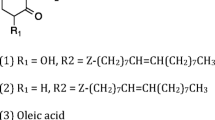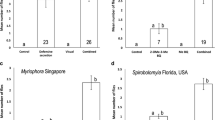Abstract
2-Acylcyclohexane-1,3-diones produced in the mandibular glands ofEphestia kuehniella Zeller (Lepidoptera: Pyralidae) fifth instars acted as arrestment and host-trail following kairomones for the parasitoid,Bracon hebetor (Say) (Hymenoptera: Braconidae). The behavioral response of the parasitoids to the kairomone varied with kairomone concentration and distribution. However, only small differences in activity were noted for the different mandibular gland components.B. hebetor females that encountered filter paper patches impregnated with the kairomone exhibited antennation and probing behavior. Females followed trails formed with 2-[(Z,E)12,14-hexadecadienoyl]cyclohexane-1,3-dione in the same manner exhibited with host-made trails. At concentrations of 1.0 μg/mm and above, trail following was interrupted by frequent probing.
Similar content being viewed by others
References
Aldrich, J.R., Kochansky, J.P., andAbrams, C.B. 1984. Attractant for a beneficial insect and its parasitoids: Pheromone of the predatory spined solider bug,Podisus maculiventris (Hemiptera: Petatomidae).Environ. Entomol. 13:1031–1036.
Benson, J.F. 1973. Intraspecific competition in the population dynamics ofBracon hebetor Say (Hymenoptera: Braconidae).J. Anim. Ecol. 42:105–142.
Corbet, S.A. 1971. Mandibular gland secretion of larvae of the flour moth,Anagasta kuehniella contains an epideictic pheromone and elicits oviposition movements in a hymenopteran parasite.Nature 232:481–484.
Dicke, M., Lenteren, J.C. Van, Boskamp, G.J.F., andLeeuwen, Dongen-van. 1984. Chemical stimuli in host habitat location byLeptopilina heterotoma (Thomson) (Hymenoptera: Eucoiiidae), a parasite ofDrosophila.J. Chem. Ecol. 10:695–712.
Hagstrum, D.W., andSmittle, B.J. 1978. Host utilization byBracon hebetor.Environ. Entomol. 7:596–600.
Haynes, K.F., andBirch, M.C. 1985. The role of other pheromones, allomones and kairomones in the behavioral responses of insects, pp. 225–255,in G.A. Kerkut and L.I. Gilbert, (eds.). Comprehensive Insect Physiology, Biochemistry and Pharmacology. Vol. 9. Pergamon Press, Oxford.
Kennedy, B.H. 1979. Effect of multilure and its components on parasites ofScolytus multistriatus (Coleoptera: Scolytidae).J. Chem. Ecol. 10:373–385.
Krombein, K.V., Hurd, P.D., Smith, D.R., andBurks, B.D. 1979. Catalog of Hymenoptera in America North of Mexico. Smithsonian Institution Press, Washington, D.C.
Kuwahara, Y., Nemoto, T., Shibuya, M., Matsuura, H., andShiraiwa, Y. 1983. 2-Palmitoyl- and 2-oleoyl-cyclohexane-1,3-dione from feces of the Indian meal moth,Plodia interpunc-tella: Kairomone components against a parasitic waspVenturia canescens.Agric. Biol. Chem. 47:1929–1931.
Matthews, R.W., andMatthews, J.R. 1978. Insect Behavior. John Wiley, New York.
Mossadegh, M.S. 1978. Mechanism of secretion of the contents of the mandibular glands ofPlodia interpunctella.Physiol. Entomol. 3:335–340.
Mudd, A. 1983. Further novel 2-acylcyclohexane-1,3 diones in the mandibular glands of lepidopteran larvae. Kairomones ofEphestia kuehniella Zeller.J. Chem. Soc. Perkin Trans. 3:2161–2164.
Mudd, A., andCorbet, S.A. 1973. Mandibular gland secretion of larvae of stored product pestsAnagasta kuehniella, Ephestia cautella, Plodia interpunctella, andEphestia elutella.Entomol. Exp. Appl. 16:291–293.
Mudd, A., andCorbet, S.A. 1982. Response of the ichneumonid parasiteNemeritis canescens to kairomones from the flour mothEphestia kuehniella.J. Chem. Ecol. 8:843–850.
Mudd, A., Walters, J.H.H., andCorbet, S.A. 1984. Relative kairomonal activities of 2-acyl-cyclohexane-1,3-diones in eliciting oviposition behavior from the parasiteNemeritis canescens (Grav.).J. Chem. Ecol. 10: 1597–1601.
Murr, L. 1930. Über den geruchsinn der mehmottenschlupswespe,Habrobracon juglandis zugleich beitrag zum orinetierungsproblem.Z. Vergl. Physiol. 2:210–270.
Nemoto, T., Kuwahara, Y., andSuzuki, T. 1987. Interspecific difference inVenturia kairomones in larval feces of four stored phycitid moths.Appl. Entomol. Zool. 22:553–559.
Nordlund, D.A., Strand, M.R., Lewis, W.J., andVinson, S.B. 1987. Role of kairomones from host accessory gland secretion in hosts recognition byTelenomus remus andTrichogramma pretiosum, with partial characterization.Entomol. Exp. Appl. 44:37–43.
Piek, T., Spanier, W., Njio, K.D., Veenendaal, R.L., andMantel, P. 1978. Paralysis caused by the venom of the wasp,Microbracon gelechiae.J. Insect Physiol. 20:2307–2319.
Salt, G. 1976. The hosts ofNemeritis canescens, a problem in the host specificity of insect parasitoids.Ecol. Entomol. 1:63–67.
Ulyett, G.C. 1945. Distribution of progeny byMicrobracon hebetor Say.J. Entomol. South Afr. 8:123–131.
Author information
Authors and Affiliations
Rights and permissions
About this article
Cite this article
Strand, M.R., Williams, H.J., Vinson, S.B. et al. Kairomonal activities of 2-acylcyclohexane-1,3 diones produced byEphestia kuehniella zeller in eliciting searching behavior by the parasitoidBracon hebetor (say). J Chem Ecol 15, 1491–1500 (1989). https://doi.org/10.1007/BF01012378
Received:
Accepted:
Issue Date:
DOI: https://doi.org/10.1007/BF01012378




